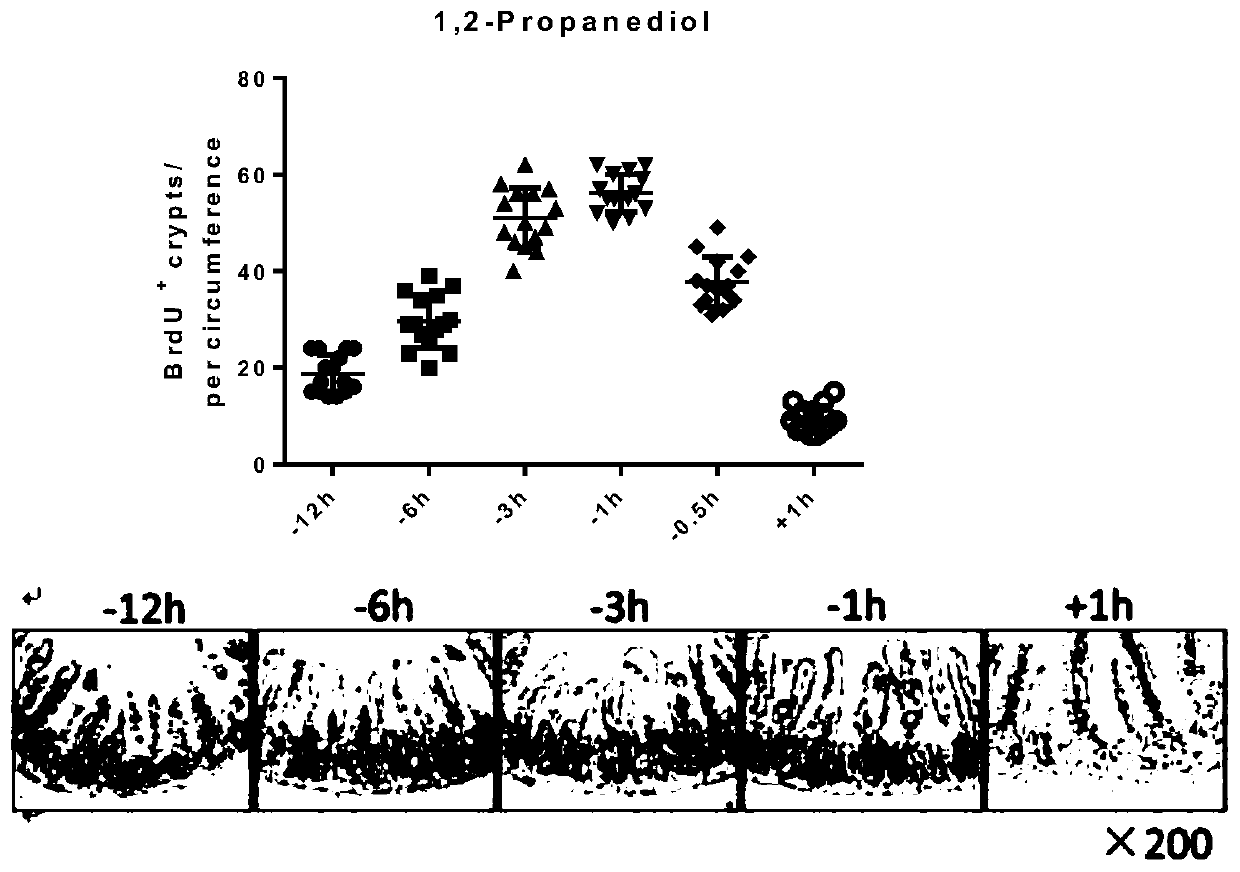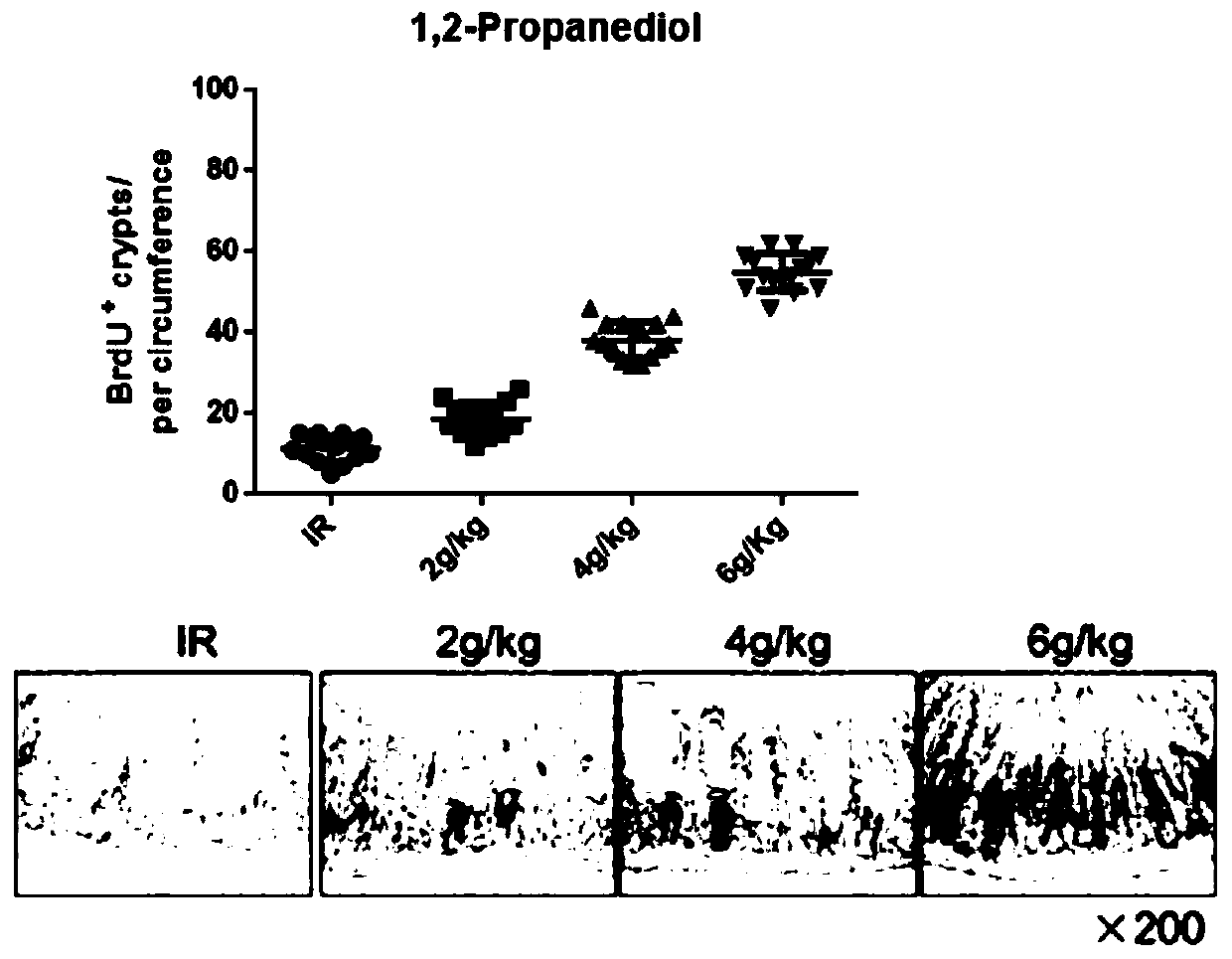Application of propylene glycol to medicine for preventing intestinal type radiation disease and radiation enteritis
A technology of radiation enteritis and propylene glycol, which is applied in the field of medicine and can solve problems such as propylene glycol that have not yet been seen
- Summary
- Abstract
- Description
- Claims
- Application Information
AI Technical Summary
Problems solved by technology
Method used
Image
Examples
Embodiment 1
[0032] Example 1. In vitro experiments showed that in vitro incubation with propylene glycol significantly reduced the apoptosis of rat intestinal crypt epithelial cells IEC-6 induced by γ-ray irradiation
[0033] We studied the effect of 1,2-propanediol and its isomer 1,3-propanediol, and preliminarily observed that alcohol compounds can reduce the radiation of epithelial cells by X-ray irradiation of rat intestinal crypt epithelial cells IEC-6. damage. IEC-6 cells were pretreated with 2% volume concentration of propylene glycol for 30 min, the IR group was given the same volume of normal saline, irradiated with 15.0 Gy (1.325 Gy / min) X-rays and replaced the complete medium for 48 h after irradiation, and passed through the flow The apoptosis rate of cells in each group was detected by cytometer, and the results were as follows: figure 1 As shown, propylene glycol pretreatment can significantly reduce the apoptosis rate of IEC-6 cells induced by radiation, and the early apop...
Embodiment 2
[0034] Example 2. Preventing intraperitoneal injection of 1,2-propanediol from reducing radiation damage to intestinal crypts in mice
[0035] In order to further prove the preventive effect of propylene glycol on intestinal radiation injury, we conducted research on intestinal type acute radiation sickness mouse model through BrdU incorporation experiment. BrdU is an analogue of thymidine, which can be incorporated into the DNA synthesized by cells like thymidine. By detecting the expression level of BrdU in mice receiving BrdU infusion, it can reflect the state of cell proliferation.
[0036] C 57 BL6 / J mice were divided into solvent control group (IR) and propylene glycol administration groups at different times. The propylene glycol administration groups were treated before (-) 12h, 6h, 3h, 1h and after (+) 15Gy X-ray whole body irradiation. 1 hour of intraperitoneal injection of 1,2-propanediol 6g / kg, the solvent control group was given an equal volume of normal saline 1...
Embodiment 3
[0037] Example 3, prevention of intraperitoneal injection of 1,2-propanediol significantly improves the survival rate of mice with intestinal type acute radiation sickness
[0038] We firstly irradiated the abdomen with X-ray 16.0Gy C 57 Observation of the protective effect of prophylactic administration of 1,2-propanediol in BL / 6J mice simulated intestinal injury model induced by radiotherapy, healthy C 57 BL / 6J mice were intraperitoneally injected with 1,2-propanediol 6g / kg or the same volume of normal saline (IR) 1 hour before irradiation, 8 mice in each group, and then all received 16.0Gy (1.325Gy / min) X-ray local irradiation in the abdominal cavity, and observed The 30-day survival rate of the mice was recorded and the body weight was recorded, and the results were as follows: image 3As shown, all the mice in the normal saline administration group died 5 days after irradiation, and the 30-day survival rate of the mice in the 1,2-propanediol prevention administration gro...
PUM
 Login to View More
Login to View More Abstract
Description
Claims
Application Information
 Login to View More
Login to View More - R&D
- Intellectual Property
- Life Sciences
- Materials
- Tech Scout
- Unparalleled Data Quality
- Higher Quality Content
- 60% Fewer Hallucinations
Browse by: Latest US Patents, China's latest patents, Technical Efficacy Thesaurus, Application Domain, Technology Topic, Popular Technical Reports.
© 2025 PatSnap. All rights reserved.Legal|Privacy policy|Modern Slavery Act Transparency Statement|Sitemap|About US| Contact US: help@patsnap.com



